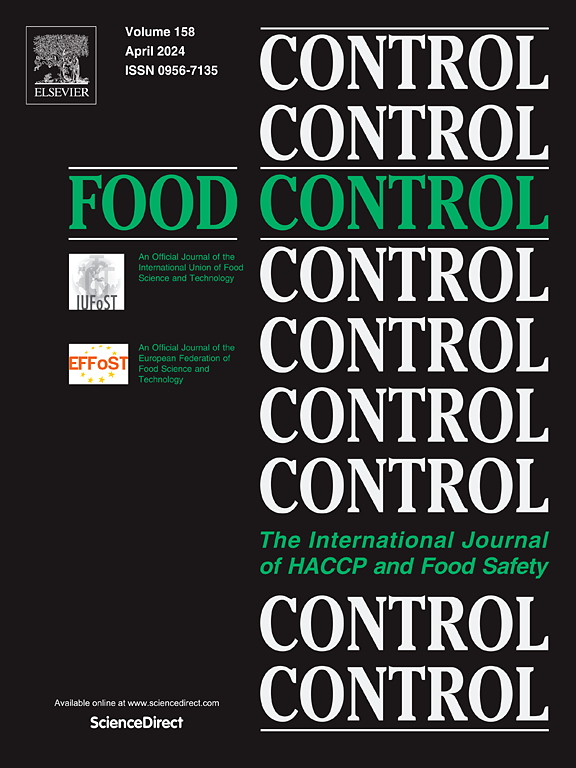山茶花皂苷抗蜡样芽孢杆菌在不同食品接触表面形成生物膜的机理和应用
IF 5.6
1区 农林科学
Q1 FOOD SCIENCE & TECHNOLOGY
引用次数: 0
摘要
蜡样芽孢杆菌是一种严重的食源性病原体。在自然界中,它能在食具和食品加工设备表面形成生物膜,难以清除。本研究选择蜡样芽孢杆菌(B. cereus)模式菌株 ATCC 10987 和 ATCC 14579 作为试验菌株,研究山茶皂苷(CS)对生物膜形成的机理和抑制作用,为开发天然抗生物膜提供新的参考。CS对蜡样芽孢杆菌ATCC 10987和ATCC 14579的生物膜具有良好的抑制作用,最小生物膜抑制浓度(MBIC)和最小生物膜根除浓度(MBEC)分别为64 mg/mL和128 mg/mL,并能通过CLSM减少蜡样芽孢杆菌的外多糖和eDNA分泌,从而破坏生物膜的结构,抑制生物膜内单个细菌的早期粘附和代谢。qRT-PCR 研究表明,CS 能下调 9 个与生物膜形成相关的基因(spo0A、codY、rpoN、comER、sinR、plcR、papR、nprR 和 LuxS)的表达,从而直接或间接地影响生物膜的形成。结合 AI-2 信号分子的半定量检测,推测 CS 通过抑制 LuxS 基因的表达来抑制蜡样芽孢杆菌生物膜的形成,是为了减少 AI-2 的产生,下调 PlcR 和 PapR 基因的表达,从而抑制由 LuxS/AI-2 和 PlcR-PapR 系统介导的法定量感应。最后,将 CS 应用于不锈钢、陶瓷和玻璃表面的结果表明,陶瓷表面对生物膜的抑制作用更强。此外,随着接触时间的延长,CS 显示出更好的抗生物膜效果。本文章由计算机程序翻译,如有差异,请以英文原文为准。
Mechanism and application of camellia saponins against Bacillus cereus biofilm formation on different food contact surfaces
Bacillus cereus is a serious foodborne pathogen. In nature, it can form biofilms on the surface of food utensils and food processing equipment, making it difficult to remove. In this study, the model strains B. cereus ATCC 10987 and ATCC 14579 were selected as test strains to investigate the mechanism and inhibition of biofilm by camellia saponins (CS), in order to provide a new reference for the development of a natural antibiofilm. CS had a good inhibitory on biofilms of B. cereus ATCC 10987 and ATCC 14579, with minimal biofilm inhibitory concentration (MBIC) and minimal biofilm eradication concentration (MBEC) of 64 mg/mL and 128 mg/mL, respectively, and could reduce the exopolysaccharide and eDNA secretion of B. cereus by CLSM, thereby destroying the biofilm's structure and inhibiting the early adhesion and metabolism of individual bacteria within the biofilm. The qRT-PCR showed that CS can down-regulating the expression of nine biofilm formation related genes (spo0A, codY, rpoN, comER, sinR, plcR, papR, nprR and LuxS), thus directly or indirectly affect the biofilm formation. Combined with semi-quantitative detection of AI-2 signaling molecules, it is speculated that CS inhibits the B. cereus biofilm formation by inhibiting LuxS gene expression is to reduce the production of AI-2 and down-regulate the expressions of PlcR and PapR genes, thus inhibiting the quorum sensing mediated by LuxS/AI-2 and PlcR-PapR systems. Finally, the application of CS on stainless steel, ceramic and glass surfaces showed that the ceramic surface had greater biofilm inhibition. Moreover, CS showed a better antibiofilm effect as contact time increased.
求助全文
通过发布文献求助,成功后即可免费获取论文全文。
去求助
来源期刊

Food Control
工程技术-食品科技
CiteScore
12.20
自引率
6.70%
发文量
758
审稿时长
33 days
期刊介绍:
Food Control is an international journal that provides essential information for those involved in food safety and process control.
Food Control covers the below areas that relate to food process control or to food safety of human foods:
• Microbial food safety and antimicrobial systems
• Mycotoxins
• Hazard analysis, HACCP and food safety objectives
• Risk assessment, including microbial and chemical hazards
• Quality assurance
• Good manufacturing practices
• Food process systems design and control
• Food Packaging technology and materials in contact with foods
• Rapid methods of analysis and detection, including sensor technology
• Codes of practice, legislation and international harmonization
• Consumer issues
• Education, training and research needs.
The scope of Food Control is comprehensive and includes original research papers, authoritative reviews, short communications, comment articles that report on new developments in food control, and position papers.
 求助内容:
求助内容: 应助结果提醒方式:
应助结果提醒方式:


